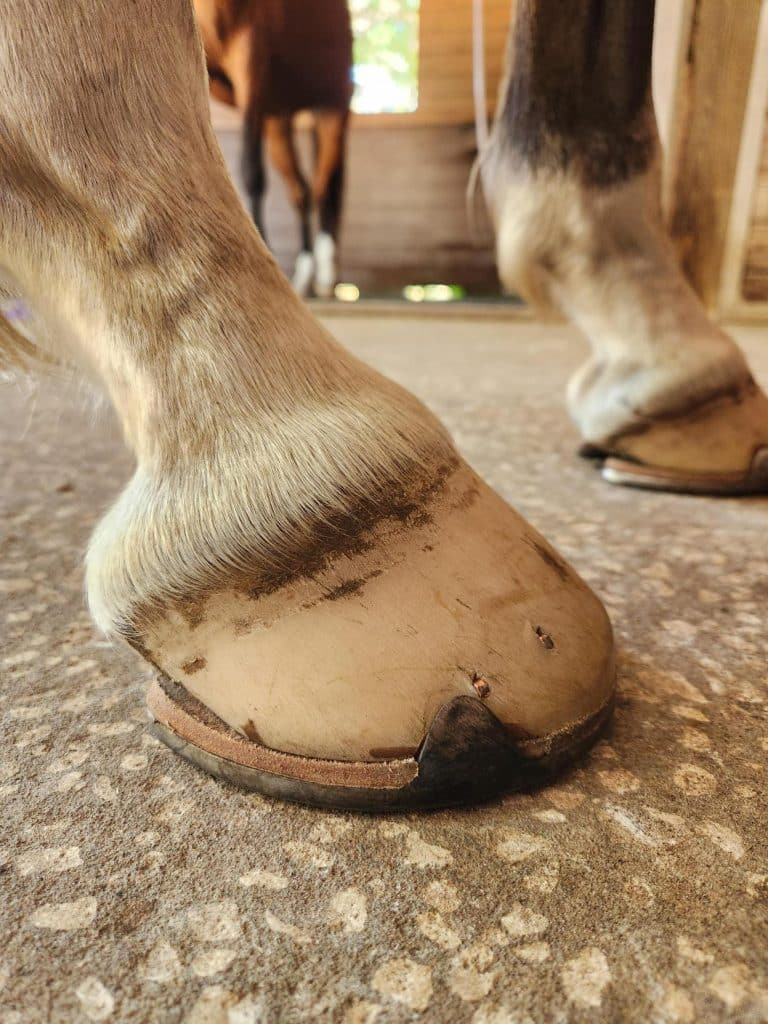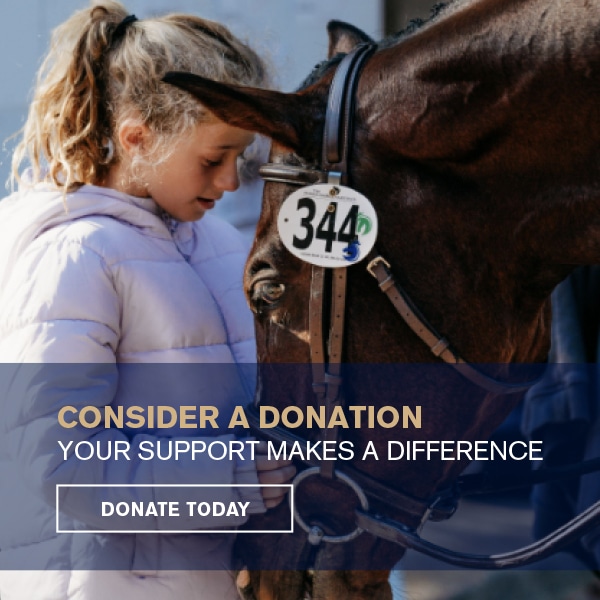
Shoes with leather pads can offer comfort and protection for horses with thin soles.
Photo credit: Stephanie J. Ruff
Thoroughbreds are celebrated for their heart and athleticism, but many come with hoof challenges that can stall progress in their second career. But with careful, consistent management, even feet with weak walls or underrun heels can adapt well to a new job.
Farrier Sean Plumlee, CJF, based in Redmond, Oregon, and veterinarian Karen Laidley, DVM, of Fruition Farm Veterinary Services, also in Redmond, agree that with the right approach, most Thoroughbreds can grow better feet over time.
Why Do OTTBs Have Poor Hoof Quality?
Weak hooves in Thoroughbreds can stem from many factors, some still not well understood.
“A lot of times their feet aren’t exactly hearty; their hoof wall can be quite thin and weak,” says Laidley, who has been practicing veterinary medicine for 27 years. “I’m sure genetics are partially to blame, and poor management, environment, and hoof care can also play a role.”
When a horse’s hoof quality has been compromised, it affects everything from his comfort level on different surfaces to long-term soundness under saddle. Plumlee, who has been a farrier for more than 25 years, sees horses come off the track needing hoof balance corrections before anything else. “I often find myself just sticking with the basics of an appropriate trim for the horse’s conformation and addressing each individual hoof accordingly,” he says.
Common Hoof Challenges in OTTBs:
- Thin soles
- Shelly hoof walls
- Long toes and underrun heels
- Flaring or distortion
- Club feet
Starting with the Trim: The Foundation of a Healthier Hoof
The trim sets the stage for growth and long-term improvement. “Most change happens in the trim,” says Laidley. “If you don’t have hoof to work with, you have to incorporate shoeing packages that … help to promote better hoof growth and balance. I’m a firm believer in using caudal support pads … and DIM (dental impression material) to mimic barefoot conditions, facilitate hoof growth and start correcting collapsed heels if the horse can tolerate frog pressure.”
One of the most common post-track issues Plumlee encounters is collapsed heels. “If the heels are running forward and low … trim them and bring them back to where the heel bulbs are straight and the buttress (the furthest weight-bearing point on the heel, where the hoof wall ends) is closer to the highest, widest point of the frog,” he says, noting that he also frequently sees inadequate vertical depth — essentially a flat, thin-soled foot. “In my opinion, creating cup (concavity of the sole) and vertical depth to the hoof capsule (through proper trimming and shoeing) is the best way to not let those thin soles become an issue.” He explains that soles less than 10 millimeters deep as seen on hoof radiographs can cause lameness.
Both professionals agree: There’s no one-size-fits-all prescription. Each foot needs to be evaluated individually with consideration for the horse’s overall conformation and comfort.
Corrective Shoeing vs. Barefoot: Choosing the Right Approach
New OTTB owners often ask whether they should keep their horse barefoot or shod. The answer depends entirely on what the horse needs. “I’m not in the ‘all shoeing’ or ‘all barefoot’ camp,” says Laidley. “I make decisions based on what the horse tells me.”
Plumlee echoes that mindset. “I usually try to keep things pretty simple, unless it’s obvious that there’s a need for handmade shoes for therapeutic reasons,” he says. “My first approach is sticking with the basics of a good trim and well-fit shoes. It takes two to three shoeings, and up to four, before I start to see the reaction of my shoeing in a horse.” Especially during the transition period, he says that simple often works best.
Shoes, pads or hoof boots can offer comfort and protection with thin soles or hard ground. But unnecessary hardware can sometimes cause more harm than good, he adds, making careful evaluation essential.
How Often Should You Trim or Reset a Thoroughbred’s Feet?
You must keep a strict schedule for foot improvement, especially in horses with hoof issues. While every six to eight weeks suits as a typical guideline, many Thoroughbreds need more frequent work early on.
Plumlee says his reset schedules vary by the horse’s needs. “More often than not, I stick with something between six and eight weeks,” he says. “Still, some horses need to be done every four or five weeks, and sometimes I’ll have a horse that needs to go beyond eight weeks to have enough hoof to work with.”
Laidley, who also runs a boarding and training facility, keeps her own horses and client horses on a regular trim schedule. “We don’t go longer than eight weeks on any of the horses here at my farm, even through the winter,” she says. For some horses, especially during a corrective phase, shorter cycles are better. Erring on the side of too soon rather than too late can help maintain proper balance, particularly as the new hoof wall grows in.
Plumlee adds that keeping up with continuing education helps him provide the best care possible. “I firmly believe in continuing education, with farriers working with other farriers, attending clinics and competitions to promote more education and increasing my overall skill set,” he says.
How Climate and Turnout Affect Hoof Health
Environment plays a major role in how a Thoroughbred’s hooves respond to care and adapt to life beyond the wire. Regional climate, barn management and footing all influence overall hoof quality and growth.
“A really wet climate can be tough in a lot of ways,” says Plumlee, “particularly when we’re dealing with a horse that is already thin-soled. An arid environment can be much more forgiving, simply because the hoof has a tendency to create more of a sole callus, and there’s definitely less hoof capsule distortion in a drier climate.”
But dryness alone doesn’t guarantee good feet. “Environmental management is huge,” says Laidley. “It’s not just about moisture; it’s also about footing. Rocky, dry, muddy, grassy can all influence what’s happening with their feet.”
A wet-dry cycle can weaken the hoof wall, while rocky terrain might lead to bruising, soreness or hoof wall chipping. For horses transitioning from stall life to pasture or vice versa, be sure to manage footing changes carefully.
Feeding the Hoof: Nutrition and Supplement Strategies
Thoroughbreds with hoof problems might benefit from targeted nutritional support, but only after you’ve balanced their diet.
“Balanced nutrition is essential,” says Laidley. “I’m not a nutritionist, but I’ve seen horses overloaded with supplements to the point where owners are supplementing the supplement. Sometimes that causes deficiencies or toxicities.”
She recommends testing your hay and asking your veterinarian to perform annual bloodwork on your OTTB. “Horses can be asymptomatic,” she explains. “One of mine turned out to have Cushing’s disease, with no symptoms. We ran routine bloodwork before doing (corticosteroid) joint injections and were shocked by the results. Clinical signs can be helpful, but bloodwork can reveal a lot.”
Owners often look to biotin, amino acids or fat-based supplements to encourage growth. Laidley found success with a simpler option. “My farrier recommended unflavored gelatin years ago,” she says. “Every horse on my farm gets it now. I believe it helps hoof quality.”
Still, no supplement will override a bad diet or fix feet overnight. In fact, Laidley says it can take anywhere from six months to a year for the hoof to grow out from the coronary band to the solar surface.
Key Nutrients for Healthy Hooves
- Biotin (20–30 milligrams/day)
- Methionine and lysine
- Copper and zinc
- Omega-3 fatty acids (especially EPA and DHA)
- High-quality protein
Visit the National Research Council’s Nutrient Requirements for Horses to find out your horse’s needs so you can see how his diet measures up, recognizing that supplementation without looking at the big picture (any forage, concentrate, or other supplements) can lead to deficiencies or overages.
Setting Expectations for Hoof Rehab in OTTBs
Too often owners hope for fast fixes, but improvement in hoof strength, depth and quality takes time and consistency. Farriers and veterinarians can set realistic expectations for owners by helping them track growth and improvement over several shoeing cycles.
Meanwhile, staying on schedule with trims, minimizing environmental stress and giving the horse time to grow in new hoof wall and sole remain essential.
Most Thoroughbreds adapt well once they settle into a routine, but you still need to pay attention to what their body tells you. “If we do the work with balanced trims, proper alignment, etc., most horses develop healthier feet,” says Laidley. “But if you ignore things, you’ll end up in trouble.”
The Key: Collaboration Between Owners, Farriers and Veterinarians
Improving hoof quality in a Thoroughbred isn’t a solo effort. Lasting results come from a coordinated team where each professional plays a role, and the owner leads with consistency and commitment.
A farrier can correct balance and support growth; a veterinarian might address underlying metabolic or other issues; and a trainer can influence how and where the horse moves, but none of these work in isolation.
“Farriers working with owners; owners taking responsibility, educating themselves; trainers doing the same,” says Laidley. “Helping horses takes a team.”
Ultimately, the person who sees the horse every day has the greatest impact. From scheduling trims to noticing early signs of discomfort, the owner drives daily care. “Be your horse’s hero,” Laidley says, a reminder that successful hoof rehab starts at the ground level.

